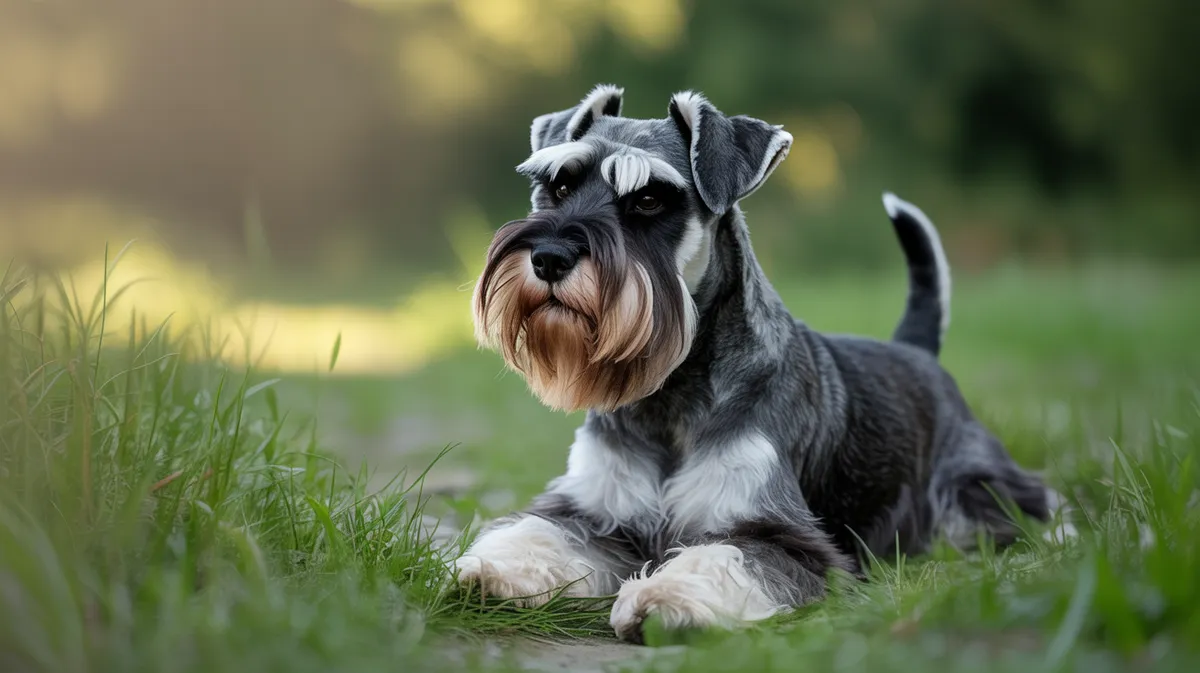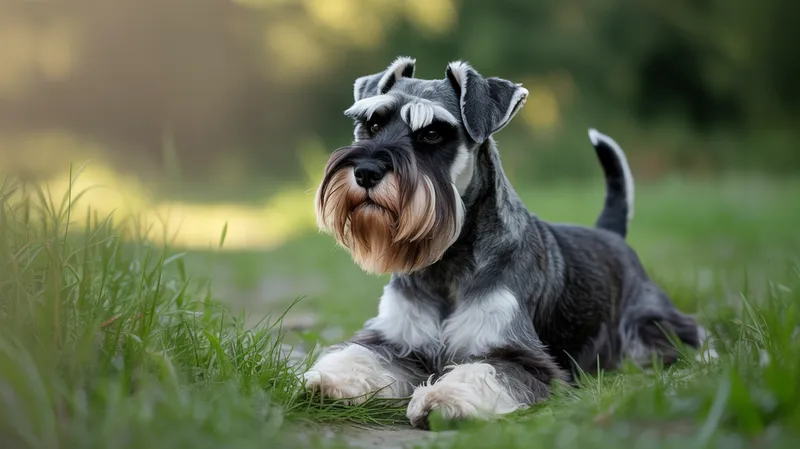
Schnauzer (Miniature)
Canis lupus familiaris

Meet the Schnauzer (Miniature)
The Miniature Schnauzer is a small, robust dog breed known for its distinctive bearded snout and bushy eyebrows. Originally bred in Germany in the late 19th century as a farm dog and rat catcher, this breed is highly intelligent, energetic, and alert. Miniature Schnauzers are beloved for their affectionate and playful nature, making them excellent family pets. They are also recognized for their adaptability and strong loyalty to their owners.
Classification
Mammal
Habitat
Domestic
Diet
Omnivore
Lifespan
12-15 years
Conservation
Least Concern
Weight
5-9 kg (11-20 lbs)
📖Fascinating Facts
Distinctive Appearance
Miniature Schnauzers are easily recognized by their expressive eyebrows, wiry beard, and square-shaped build.
Family-Friendly
These dogs are known for being excellent companions for children and adults alike, thanks to their affectionate and outgoing personalities.
Born Rat-Catcher
Originally bred to control vermin on farms, the Miniature Schnauzer retains a strong prey drive and enjoys chasing small animals.
📋Detailed Description
The Miniature Schnauzer (Canis lupus familiaris) is a compact, robustly built dog, typically weighing between 5–9 kg (11–20 lbs) and standing 30–36 cm (12–14 in) at the withers for males, with females slightly smaller. Notable for its rectangular, muscular frame, the breed features a distinctive harsh, wiry double coat, which is hand-stripped for show but often clipped in pet dogs, and a pronounced beard and bushy eyebrows that accentuate its expressive face. The head is strong and elongated, with a moderate stop and a powerful, square muzzle. Ears are set high and may be cropped or left natural, folding forward in a V-shape. Eyes are oval, dark, and keen, reflecting the breed’s alert temperament. The tail is customarily docked in some countries, but natural tails are increasingly common. Miniature Schnauzers are highly intelligent and responsive, with a lively, outgoing disposition. They are known for their adaptability to various living environments, from rural farms to urban apartments, and their strong loyalty and attachment to family members. Their keen senses and vocal tendencies make them excellent watchdogs, though they are generally not aggressive. The breed exhibits a moderate energy level, requiring regular exercise and mental stimulation. Life expectancy averages 12–15 years, with some individuals reaching 16 or more under optimal care.
💡 Did you know?
The Miniature Schnauzer is one of the few terrier breeds not originating from the British Isles.
🔬Research & Sources
Wikipedia Summary
The Miniature Schnauzer is a breed of small dog of the Schnauzer type that originated in Germany in the mid-to-late 19th century. Miniature Schnauzers may have been developed from the smallest specimens of the Standard Schnauzer, or crosses between the standard and one or more smaller breeds such as the Affenpinscher, Miniature Pinscher, and Poodles, as farmers bred a small dog that was an efficient ratting dog. They are described as "spunky" but aloof dogs, with good guarding tendencies without some guard dogs' predisposition to bite. Miniature Schnauzers are recognized in four colors internationally: solid black, black and silver, salt and pepper, and white.
Last Modified: 5/23/2025
🎭Behavior & Social Structure
Miniature Schnauzers are alert, energetic, and inquisitive, exhibiting a pronounced terrier-like drive for exploration and play. Historically bred as ratters, they retain a strong prey drive and may chase small animals, though their sociability generally extends to other dogs and household pets when properly socialized. They are known for their intelligence and trainability, excelling in obedience, agility, and scent work. Daily routines typically include periods of energetic play, brisk walks, and interactive activities that challenge their minds. Socially, Miniature Schnauzers form close bonds with their human families and may display protective behaviors, barking to alert owners of strangers or unusual activity. While affectionate and playful with children, they can be reserved or aloof with unfamiliar people. They are not prone to separation anxiety but thrive on companionship and regular engagement. Feeding behavior is typical of small breeds, with a tendency toward food motivation, which can be harnessed for training but also necessitates portion control to prevent obesity.
👶Reproduction & Life Cycle
Miniature Schnauzers reach sexual maturity between 6–12 months, though responsible breeding is recommended after 18 months of age. The breed is monoestrous, with females coming into heat approximately twice yearly. Mating is typically natural, though artificial insemination may be used in breeding programs. Gestation lasts about 63 days, and litters range from 3 to 8 pups, with 4–6 being average. Whelping is generally uneventful, but small breed dystocia can occur. Neonates are altricial, requiring intensive maternal care. The dam nurses and cleans the pups, with weaning beginning at 3–4 weeks and completed by 6–8 weeks. Breeders emphasize early socialization during the critical period (3–12 weeks) to foster stable temperaments. Miniature Schnauzers are not seasonal breeders and can reproduce year-round, though ethical breeders limit frequency to preserve maternal health.
🛡️Adaptations & Survival
The Miniature Schnauzer’s wiry, double-layered coat provides protection from harsh weather and underbrush, an adaptation from its origins as a farm and ratting dog. The pronounced beard and eyebrows shield the face and eyes from debris and bites during hunting. Their compact, muscular build allows for agility and endurance in confined spaces, while their keen senses of hearing and smell aid in detecting vermin. Behaviorally, their intelligence and problem-solving abilities are evolutionary advantages for working breeds, enabling them to learn complex tasks and adapt to varied environments. The breed’s vocal tendencies serve as an early warning system, a trait selected for in watchdog roles. Their social flexibility and strong human bonding are adaptations to domestic life, enhancing their role as companion animals.
📚Research Sources
🎨Cultural Significance
The Miniature Schnauzer holds a prominent place in Western culture as a symbol of alertness, loyalty, and spirited companionship. Originating in Germany, the breed was historically valued by farmers for its vermin control abilities and adaptability to smallholdings. In the 20th and 21st centuries, Miniature Schnauzers have become popular family pets and show dogs, frequently appearing in media, advertising, and dog sports. Their distinctive appearance and expressive personalities have made them cultural icons in many countries. The breed is not associated with specific mythological or symbolic roles but is often depicted as a model of the ideal small companion dog.
🔬Recent Research & Discoveries
Recent genetic studies have clarified the Miniature Schnauzer’s ancestry, confirming contributions from Standard Schnauzers, Affenpinschers, and possibly Poodles, with selection for size and temperament. Ongoing research focuses on breed-specific health issues, especially genetic markers for eye diseases and metabolic disorders. Studies in canine cognition have highlighted the breed’s high learning capacity and responsiveness to human cues. The Miniature Schnauzer is also a subject in research on canine obesity and lipid metabolism, given its predisposition to hyperlipidemia. Advances in veterinary care, including genetic screening and targeted therapies, are improving breed health outcomes. The breed’s adaptability and intelligence continue to make it a model for studies in canine behavior and human-animal interaction.
🎥Wildlife Videos

A Schnauzer & Bald Guinea Pig Strike Up a Friendship 🥰 Amazing Animal Friends | Smithsonian Channel
Dogs and guinea pigs are meant to be natural enemies–so how do you explain the friendship between Charlotte, a miniature ...
Smithsonian Channel

Miniature Schnauzer Dog Breed Hidden Information Will Shock You
Today's video is about the Miniature Schnauzer Dog Breed Information. Please Subscribe ...
Amazing Dogs

Miniature Schnauzer and Cozy Nights: Cuddling Up for Movie Marathons
Miniature Schnauzer and Cozy Nights: Cuddling Up for Movie Marathons Introduction: .When it comes to finding the perfect ...
American Dog Stories

Guinea Pig Is Best Friends With Dog | Oddest Animal Friendships | Love Nature
A rodent-hating schnauzer is best friend with her owner's skinny pig (naked guinea pig)! Charlotte eats Wallace's guinea pig food ...
Love Nature

Miniature Schnauzer in backyard
Under southern California warm sunshine our miniature Schnauzer stay in the yard and enjoy warm, quiet and happy time.
PuppyWorld
🌍Habitat Information
The Schnauzer (Miniature) typically inhabits Domestic environments. Schnauzer (Miniature)s have adapted to their environments with specialized features and behaviors.
Primary Habitat:
Domestic
More detailed habitat information will be available soon.
🛡️Conservation Status
The Schnauzer (Miniature) is currently classified as Least Concern. Conservation efforts are crucial for preserving this species for future generations.
Common Threats:
- 🏠Habitat loss and fragmentation
- 🌡️Climate change impacts
- 🎯Hunting and poaching
- 🏭Human-wildlife conflict
⚠️Threats & Conservation Challenges
Miniature Schnauzers face few threats in terms of population viability, as they are a popular and widely bred companion animal. However, the breed is predisposed to certain hereditary health issues, including hyperlipidemia, pancreatitis, cataracts, progressive retinal atrophy, and urinary stones. Overbreeding and irresponsible breeding practices can exacerbate these conditions. Obesity is a common challenge due to their food motivation and small size. In some regions, breed-specific legislation or restrictions on tail docking and ear cropping impact traditional breed standards. Human impact is largely positive, with strong demand for the breed, but puppy mills and commercial breeding operations pose welfare concerns. Population trends remain stable or increasing globally.
🔬Scientific Classification
Scientific Name
Canis lupus familiaris
Classification Hierarchy
🔍 About Taxonomic Classification
Taxonomic classification is a hierarchical system used by scientists to classify and organize living organisms based on shared characteristics and evolutionary relationships.
The system moves from broad categories (Kingdom) to increasingly specific ones, with each animal's scientific name typically consisting of its Genus and species.
📝Community Notes
Share your observations and insights about the Schnauzer (Miniature) with our community of wildlife enthusiasts.
Join Our Community
Sign in to share your observations and connect with fellow wildlife enthusiasts.
Sign In to ContributeNo community notes yet
Be the first to share your observations about the Schnauzer (Miniature)!
Explore Schnauzer (Miniature)
Select a tab above to learn more about this amazing animal.
📸Photo Gallery
No photos available for this animal yet.
🌟Discover More Wildlife
Continue your journey of discovery with more fascinating animals from our database
